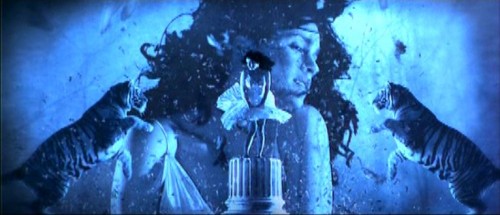Revenge Is a Dish Best Served…Not at All? by Angelina Rodriguez
Tarantino’s Kill Bill narrative requires The Bride to murder her rapist and to defend herself with some of the masculine characteristics that are used as institutionalized power to oppress women, such as physical strength and aggression. The film insists that she seek revenge, instead of demanding that men simply do not rape. This is barely better than teaching rape avoidance. It dictates that women must assimilate to a male culture of violence in order to have autonomy over their own bodies.
Irreversible: Deconstructing Rape Revenge by Max Thornton
“I’ll Make You Feel Like You’ve Never Felt Before”: Jennifer’s Power in I Spit on Your Grave Sophie Besl
No movies ever had to justify a cowboy going on a rogue revenge kick after his log cabin was burned to the ground or his family was killed; certain sufferings of injury, murder of loved ones, robbery, etc., have been accepted throughout cinematic history to merit revenge at all costs. I Spit on Your Grave was a large part of a relatively new phenomenon, possibly born out of the feminist movement, to add rape—based on the woman’s experience of rape, whether validated by law or not—to that list of worthy harms, which is an important statement in our rape culture.
When Biopics Go Awry: Bandit Queen As Rape Revenge by Colleen Lutz Clemens
The Fractured Rape/Revenge Fantasies of Julie Taymor’s Titus by Rebecca Willoughby
Julie Taymor’s contemporary approach to creating a film of Titus Andronicus then, has to address a variety of factors: 1) she has set up for herself the challenge of filming a Shakespeare play that has been called both an “early masterpiece” and an “Elizabethan pot-boiler”; 2) she’s a female director approaching a play that has, at its center, a ritual killing, a rape, and revenge cannibalism; and 3) she’s creating this piece of art during a historical moment during which entertainment media is rife with violence and there much alleged desensitization, as well as within a culture full of complex and problematic attitudes about rape.
Women As Perpetrators of Violence in Freeway by Ren Jender
In films, as in life, women aren’t supposed to be violent. Women make up the majority of violent crime victims (domestic violence, assault, rape, and murder) but they rarely retaliate in kind. Even in the relatively rare film where a woman seriously injures or kills a rapist, like Thelma and Louise she does so with lots of tears and anguish–in that film both from the woman pulling the trigger and the one who the man attempted to rape. The unwritten rule in movies seems to be that in order to justify a woman killing or even assaulting someone, we need to see her or some other woman suffer, a lot, beforehand. Contrast that rule with the male heroes of action films who leave dozens of corpses in their wake, and not one of the dead, usually, has raped or otherwise tortured the hero beforehand–though the hero may be avenging some great wrong the dead guy (or guys) did to his wife or daughter.
Cowboy Justice: Rape Revenge in Mainstream Cinema and TV by Morgan Faust
So maybe what had looked like a trend toward marginalizing rape survivors was actually a move toward bringing them into the fold of the American action hero? This is a move that discloses a terrible truth about the handling of rape cases in our legal system, but can be viewed as a genuine attempt to find a way to make the cowboy narrative, and the catharsis that comes with it, available and relevant to survivors of rape.
What Shakespeare Can Teach Us About Rape Culture by Leigh Kolb
In Titus Andronicus, Lavinia is brutally raped and disfigured (including having her tongue cut out so she couldn’t speak). This nod to Philomela in Ovid’s Metamorphoses echoes the themes of the brutality of rape and the need for revenge. The women needed to name their rapists and share their stories (Lavinia writes in the sand; Philomela weaves a tapestry that tells her story). The women have as much power as they can in the confines of their society, and we the audience are meant to want justice and revenge.
On Milk-Bones, Toothed Vaginas, and Adolescence: Teeth as a Cautionary Tale by Colleen Lutz Clemens
But when Dawn learns that Ryan has bedded her as part of a bet while he is still inside of her, Dawn’s evolutionary adaptation intercedes and Ryan is punished for his use and abuse of Dawn. So now two trusted boyfriends and a doctor have initiated Dawn into the world of oppressive sex and violence, and all three times her vagina—the thing that has left her most vulnerable—has acted as a protector.
More than being shitty to watch, it just pissed me off to 10 because I hate with the fiery passion of 10,000 suns the ubiquitous trope that surviving sexual violence (or attempted sexual violence) turns women into superheroes.
Trespassed Lands, Transgressed Bodies: Horror, Rage, Rape, and Vengeance Within Indigenous Cinema by Ariel Smith
By forcing the subconscious fears of audiences to the surface, horror cinema evokes reactions psychologically and physically–that is its power. This power can serve and support uncensored Indigenous expression by allowing Indigenous filmmakers the opportunity to unleash dark, unsanitized allegorical representations of the abhorrent, repugnant, violent abomination that is colonization.
Rape, Lies, and Gossip on Gossip Girl by Scarlett Harris
Her banishment by Blair when she finds out what transpired between Jenny and her on-again, off-again lover is typical of the punish-the-woman mentality Gossip Girl is so fond of. Instead of shaming her partner for taking advantage of a teenage girl, Blair blames Jenny for ruining her proposal. And when Jenny returns the following season to help Chuck take down Blair (keep up, people!), she should really be seeking revenge on her rapist, wouldn’t you say?
Girl Gang Fights Rape Culture in Firefox by Elizabeth Kiy
Though very different, the two films based on Joyce Carol Oates’ novel, Foxfire: Confessions of A Girl Gang, have a shared message: that rape culture is pervasive. and the experiences of girls and women within it are sadly, universal. In both films, one set in the 90s, the other in the 50s, teenage girls inhabit dangerous territory, full of sexual assaults and near misses, all ignored by the authorities around them. Their experiences aren’t considered unusual or justified within their respective narratives, instead, they point out that women are given a lot of reasons to feel unsafe and afraid in our society. At the very least, we’ve all been told not to walk home at night or frightened by a man following too close on our heels.
Agency and Gendered Violence in Thelma and Louise by Jenny Lapekas
These characters challenge our gendered assumptions about sex, trauma, and vengeance, which can make audiences uncomfortable. I was likely too young when I first watched Thelma and Louise (Ridley Scott, 1991). However, I remember the surge of adrenaline I felt when Louise shot and killed Thelma’s rapist, how incredibly good it felt to idolize these convict women who had had enough with their monotonous lives, at an age when I couldn’t possibly comprehend patriarchal oppression, the comforts of solidarity and sisterhood, or the concept of escapism utilized not necessarily to run away but rather to find your wildest, most genuine self.











